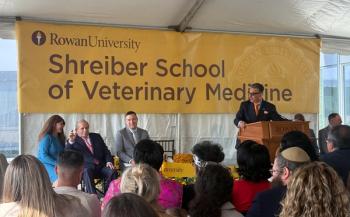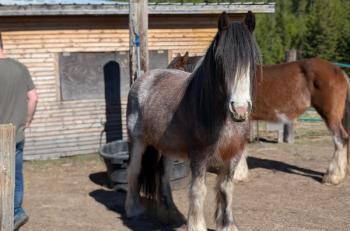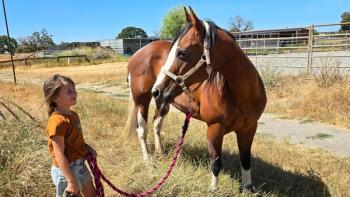
Genetic disorders affecting equine neonates (Proceedings)
New information cerebellar abiotrophy of Arabians, Severe Combined Immunodeficieincy (SCID) of Arabians, Lavender foal syndrome of Arabians, Lethal White Syndrome of overo Paints, Glycogen Branching Enzyme Deficiency (GBED) of Quarter Horses, hemophila and thrombobasthenia will be discussed.
New information cerebellar abiotrophy of Arabians, Severe Combined Immunodeficieincy (SCID) of Arabians, Lavender foal syndrome of Arabians, Lethal White Syndrome of overo Paints, Glycogen Branching Enzyme Deficiency (GBED) of Quarter Horses, hemophila and thrombobasthenia will be discussed.
Inherited verses congenital defects.
Congenital defects are structural or functional defects that may or may not be present at birth. Many disorders lead to embryonic death, fetal loss, abortion, still birth, premature birth or dysmaturity. Not all congenital defects are genetic in origin, and it is important to distinguish between environmental and genetic causes.
Genetic information.
One set of chromosomes is inherited from each parent, therefore mammals have two copies (alleles) of every gene. Simple traits (Mendelian) are inherited in dominant or recessive patterns, while polygenic traits (like speed or milk production) are determined by the combined effects of many genes.
Recessive inheritance.
Two affected copies of the gene are required to cause disease. The condition can be autosomal or sex-linked (defect on either the X or Y chromosome) Autosomal recessive traits result in an inability to produce a functional protein. Heterozygous individuals inherit one abnormal and one normal allele which can make the functional protein. Heterozygotes are carriers of the condition, but can only produce affected individuals if they are bred to another heterozygote.
Unaffected carrier parents can produce affected offspring, thus the condition can be silent and appear to skip generations. Mating an affected to a normal homozygous individual will result in all offspring that appear normal, but all offspring will be carriers. Breeding two carriers results in approximately 25% normal, 50% carrier and 25% affected offspring.
• Examples: GEBD of QH, SCID of Arabians and probably cerebellar abiotrophy and lavender foal syndrome of Arabians.
Dominant inheritance
Diseases with a dominant mode of inheritance only require one affected allele to express the trait. There is no distinguishable difference between the affected phenotype of the heterozygote and homozygote (exception- see co-dominant). Dominant traits result in a dysfunctional protein. There may also be normal protein produced by the normal allele, but this may be insufficient for normal function.
Affected individuals must have at least one affected parent (unless it is a new mutation), and therefore the disorder does not skip generations. Approximately half the offspring of a heterozygote will be inherit the affected allele and show disease.
• Examples: PSSM, RER?
Co-dominant
If a condition is inherited in a dominant fashion, but homozygotes are affected to a greater degree than heterozygotes the inheritance pattern is considered co-dominant or semi-dominant.
• Examples: HYPP in QH and lethal white in Paints
Sex-linked traits
Defects in the genes on either the X or Y chromosome result in sex-linked traits. Males are more susceptible because they only have one each of the X and Y chromosomes, and no "back-up" copy.
X-linked recessive
X-linked recessive traits appear more frequently in males than females, with half of the sons of carrier females being affected.Half the daughters of a carrier female will be carriers.
• Example: Hemophilia A
X-linked dominant
Affected offspring must have one affected parent, the defect does not skip generation, and an affected male bred to a normal female will transmit the mutation to all his daughters and not his sons.
Y-linked traits
Y-linked disorders are extremely rare, as there are very few genes on the Y chromosome and most of these are involved in male fertility. Defects in these genes therefore render the affected male infertile.
Web-sites
OMIA Online Mendelian Inheritance for Large Animals
Veterinary Genetics Laboratory at the University of California, Davis: horse
•
•
Inherited disorders of horses
Cerebellar abiotrophy of arabian foals
Foals are generally born normal, but around 6 weeks of age the disease causes death of cerebella neurons leading to head tremors (intention tremor) and a loss of balance. Classic cerebellar disturbances result in ataxia, and inability to regulate the rate, range, and force of movement. There is often dysmetria (hypermetria with higher and longer flight of the limb) or hypometria. Initiation of movement may be jerky, and truncal sway is common. Spasticity caused by hypertonia results in stiff, jerky movements. There is no paresis, although hypotonia can make a horse appear weak or drag its toes. Intention tremor is obvious with severe diffuse cerebellar disease.
Cerebella abiotrophy is a genetic defect. Currently the incidence of the disease is unknown as many breeders are reluctant to disclose that their breeding stock has produced a foal with neurologic disease. Affected foals are generally euthanized, but can exist as pasture pets. They should never be ridden and are prone to injury. Both parents are likely to be carriers. Researchers at UC Davis are attempting to identify the defective gene which will eventually result in the availability of a genetic test to identify carriers.
Idiopathic epilepsy of egyptian arabian foals
Onset of seizures usually at 3-9 months of age. Good response to anticonvulsants (diazepam then phenobarbital). Monitor Phenobarbital serum levels after 14 days [10-40 µg/ml]). Foals usually outgrow the condition after about 3 months of anticonvulsant therapy. Long term prognosis is excellent.
Lavender foal syndrome
Egyptian Arabians with abnormal hair color that are born with opisthotonus. Foals may be able to nurse, but have periods of joint rigidity and nystagmus. Foals should be euthanized, as the condition is generally fatal with 72 hours. Vacuolation of neurons is found on brain histopathology.
Combined immunodeficiency (cid) of arabian foals
A lethal genetic defect of Arabian and Arab cross foals, which results in failure to produce functional B and T lymphocytes, resulting in lack of antigen-specific immune responses. Recent DNA testing indicates a carrier rate of 8% in the USA. Carrier x Carrier = 25% homozygous (affected); 50% heterozygous (carrier); and 25% genotypically and phenotypically normal.
Clinical signs
1. Usually normal at birth, with clinical signs of infection appearing at 1-3 months.
2. Infection occurs as passive immunity wears off - usually pneumonia (Adenovirus, Pneumocystis carinii, Rhodococcus equi) or diarrhea (Cryptosporidium parvum), omphalophlebitis or septic arthritis.
3. May respond briefly to antimicrobials, but eventually uniformly fatal.
Diagnosis
Generic testing: foal is homozygous for the SCID gene using whole blood or cheek swabs.
Previously, an antemortem diagnosis was suggested by persistent lymphopenia (< 1000/µl and often < 500/ul) and absence of serum IgM by RID on presuckle serum or after day 35 when all colostral IgM has disappeared. Lymphoid hypoplasia within the spleen, thymus and lymph nodes is observed at necropsy.
Prevention
Identification and elimination of carriers for breeding. A DNA test identifies carriers (VetGen, Ann Arbor, MI;
Lethal white syndrome
An autosomal recessive condition occurring from breeding two overo Paint horses. Foals are white (occasional small colored patches) with congenital ileocolonic aganglionosis. The inherited defect is in the endothelin receptor gene. No fecal material is passed. Foals are initially bright and nurse well, but become increasingly distended and colicy. Occasional pure white foals of over-over mating are born without this condition, therefore a period of treatment is recommended to rule out meconium impaction. Foals should be euthanized if there is no response to flunixin and enemas. The colon often appears small at necropsy.
Glycogen branching enzyme deficiency (gbed) of quarter horses
GBED is an autosomal recessive disease of Quarter Horse and related breeds related to the foundation sire "King". When GBE is deficient, glycogen in tissues lacks the normal branched structure and thus foals cannot effectively store sugar molecules. Tissues that rely heavily on glycogen as a fuel are skeletal muscle, heart muscle, and the brain.
Clinical signs
Late term abortion or stillbirth can occur, with at least 3% of abortions in Quarter horses due to GBED. Foals that are born alive may appear weak or initially normal. They eventually demise with the development of seizures, becoming too weak to stand, or in some cases, sudden death may occur. All known cases of GBED have been euthanized or died by 18 weeks of age.
Diagnosis
DNA testing of carriers can be performed on tail hair roots. UC Davis
Commonly GBED foals have a low white blood cell count. They may be hypoglycemic had have elevated CK, AST and GGT.
Prevention
The mutation is present in about 10% of all Quarter Horses. Breeding carriers results in a 25% chance of getting an affected foal.
Congenital clotting factor factor deficiencies
Congenital factor deficiencies are most likely to cause large hemorrhages into body cavities (melena, hematuria, hemoabdomen, hemothorax) or produce subcutaneous hemorrhages, hemarthrosis, epistaxis or continued hemorrhage after trauma or surgery. Petechiae are not observed as in platelet disorders. Deficiencies of factor VIII (Hemophilia A), factors IX, XI and XII and prekallikrein have been reported in horses, as has von Willebrand's disease.
Factor VIII deficiency (Hemophilia A) is sex-linked and recessive, occurring only in males. Factor XI deficiency does not result in clinical signs. Factors VIII and IX must be reduced to less than 5% before spontaneous hemorrhage occurs. Differentials include acquired coagulation factor-deficiencies from DIC, warfarin toxicity, moldy sweet clover poisoning and acute sever hepatic disease.
The inherited coagulopathies involve proteins in the intrinsic pathway (XII, XI, IX, VIII) therefore activated partial thromboplastin time (aPTT) will be prolonged, and prothrombin (PT) will be normal. Platelet count should be normal. In contrast acquired coagulation factor-deficiencies involve proteins in the extrinsic or common pathways causing increases in both the PT and aPTT.
Blood can be sent to special lab (Cornell University) for quantitative measurement of specific factors. Special handling is required. Also contact Dr. Boudreaux at Auburn as she may be interested in cloning the gene for you!
Long term prognosis is poor. Intermittent plasma transfusions can be used to provide clotting factors. Plasma transfusions will be required for life.
Glazmann's thrombasthenia
A rare inherited platelet defect caused by a change in the platelet glycoprotein complex IIb-IIIa. The IIb-IIIa complex is responsible for platelet aggregation acting as a receptor for fibrinogen. Although individuals have normal platelet numbers and cytologic appearance, the platelets are non-functional. Affected horses have epistaxis, gingival bleeding, and petechial and ecchymotic hemorrhages on mucosal surfaces. Mild anemia may be present due to the chronic bleeding. Platelet count, PT, aPTT, thrombin time (TT), and von Willebrand's factor concentrations are all normal. Gingival bleeding time is prolonged (>60 minutes, verses < 2 minutes in control horses). Dr. Pete Christopherson at Auburn University has developed a genetic test for this disorder in horses, and we have one affected horse in our teaching herd! No treatment is available.
Newsletter
From exam room tips to practice management insights, get trusted veterinary news delivered straight to your inbox—subscribe to dvm360.






